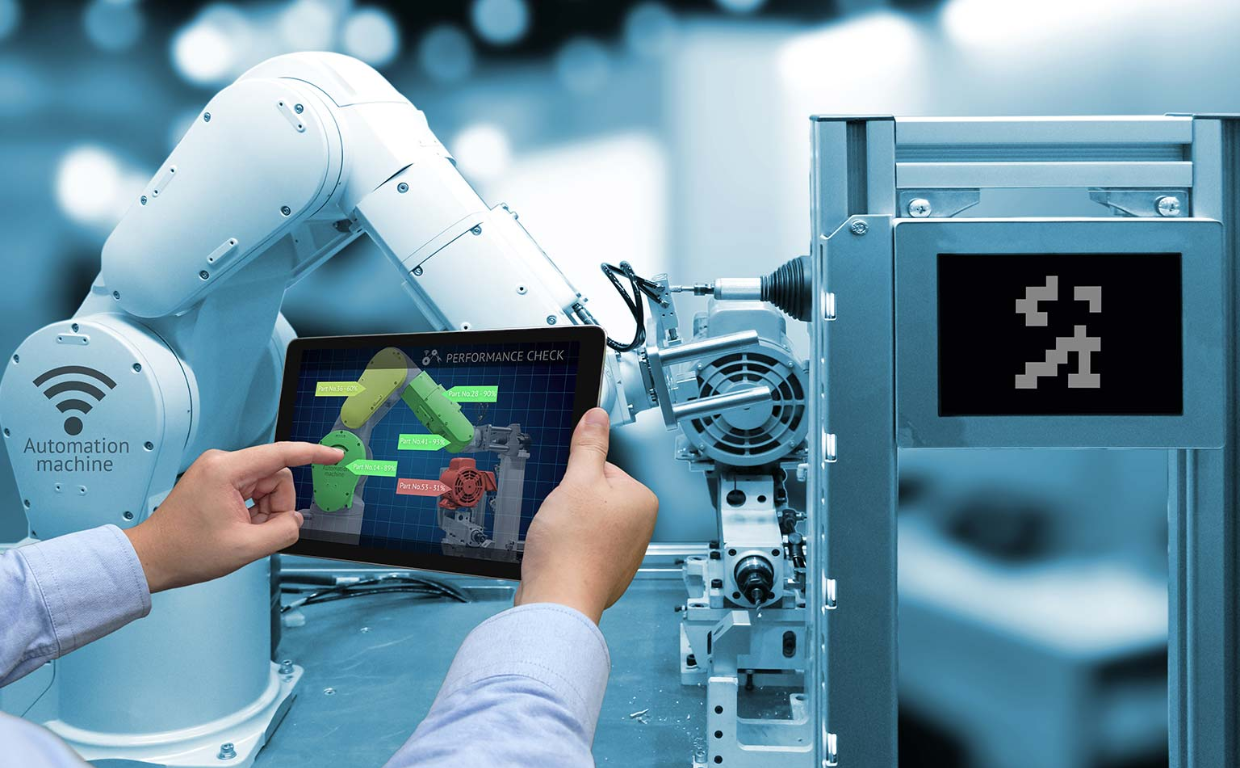
The Internet of Things (IoT) is revolutionizing the manufacturing industry by creating smart factories that operate with unparalleled efficiency. From predictive maintenance to real-time analytics, IoT integration helps manufacturers optimize processes, reduce downtime, and improve overall productivity. In this blog, we explore how IoT is transforming traditional factories into intelligent systems.

Understanding IoT in Manufacturing
IoT in manufacturing refers to the use of connected sensors, devices, and machinery that communicate with each other to gather and share data. This network of physical objects helps monitor conditions, performance, and productivity levels. Unlike traditional automation, IoT enables real-time decision-making and adaptive processes.
For example, a temperature sensor in a machine can detect overheating and trigger alerts before breakdowns occur. This predictive approach helps reduce maintenance costs. Learn more about Advanced Technology Integration in manufacturing on our services page.
Major companies like Siemens and GE have adopted IoT to streamline manufacturing. Their case studies show reductions in downtime by over 40%. GE Digital has published detailed reports on how their smart manufacturing solutions work.
IoT technology also provides better visibility into the entire production chain. Managers can remotely track operations across multiple plants from a single dashboard. This leads to better coordination and timely decision-making.
Manufacturing analytics driven by IoT are capable of identifying patterns that improve inventory management and production planning. Companies can adapt more easily to demand fluctuations.
With seamless data integration, IoT eliminates manual reporting and paperwork, reducing human errors and time spent on administration.
For industries like automotive, electronics, and pharmaceuticals, adopting IoT is no longer optional but essential for staying competitive in a global market.
Reducing Downtime with Predictive Maintenance
Downtime is a costly issue in manufacturing. IoT helps prevent equipment failures by using sensors that monitor temperature, vibration, and other parameters in real time.
Instead of waiting for a machine to fail, predictive maintenance uses AI algorithms to forecast breakdowns and alert staff. This significantly extends machinery lifespan.
Case studies from Bosch and Hitachi show how predictive maintenance cut their repair costs by 30% and increased uptime by 25%. You can read their results here.
Maintenance schedules can also be automated, ensuring that checks are done without needing manual reminders or human intervention.
Reducing unplanned downtime helps maintain production flow and reduces delivery delays, which is crucial in today’s fast-paced supply chain.
Our team at Mahi Media Solutions has helped clients integrate predictive analytics into their operations with great success.
Smart factories that implement predictive maintenance experience improved resource allocation and higher safety standards.
Real-Time Quality Control
IoT-enabled cameras and sensors can monitor product quality during production, eliminating the need for post-production inspections.
Defects are detected instantly, allowing manufacturers to correct issues without halting the entire process.
Companies like Foxconn have implemented visual inspection systems powered by AI and IoT, improving defect detection rates by 60%.
By automating quality control, factories can reduce waste and ensure consistent output. This is particularly useful in industries like electronics and pharmaceuticals.
Real-time quality control ensures that only high-standard products reach customers, enhancing brand reputation and reducing returns.
Data collected from inspections can be stored for audits, compliance, and process improvement analysis.
Learn how we implement intelligent solutions for quality assurance on our Digital Transformation page.
Energy Optimization
Energy costs can significantly impact a manufacturer’s bottom line. IoT devices help track energy consumption in real time.
Factories can identify high-usage zones and adjust schedules or equipment to save energy.
Smart lighting, HVAC systems, and automated power-down modes reduce wastage during non-productive hours.
According to a report by McKinsey, manufacturers using IoT for energy management saw reductions in energy costs of up to 20%.
Energy optimization also supports sustainability goals, a growing concern for many global brands.
Systems can automatically adjust energy settings based on shift patterns or ambient conditions, without human input.
Visit our Services page to learn how we implement energy-efficient technologies for our clients.
Enhancing Worker Safety
IoT solutions can improve safety in manufacturing environments through wearable tech and sensor-based alerts.
Wearables monitor vitals like heart rate and body temperature to prevent accidents due to fatigue or heat exposure.
Hazard detection sensors can alert teams about gas leaks, machinery malfunctions, or unsafe zones in real time.
Injury rates have decreased in factories using IoT-based safety systems. Companies like Honeywell are pioneers in this domain.
IoT also allows for contact tracing and social distancing monitoring, which became vital during the pandemic.
We help businesses integrate IoT safety systems to comply with OSHA standards and protect their workforce.
Read about these integrations on our Technology Consulting page.
Supply Chain Optimizatio
IoT allows real-time tracking of raw materials, shipments, and inventory levels throughout the supply chain.
Smart tags and RFID sensors offer accurate data about product locations and conditions.
This reduces lead time, minimizes stockouts, and prevents overstocking, saving companies both time and money.
With integrated logistics data, manufacturers can better align production schedules with delivery timelines.
Companies like Amazon and Dell use IoT to optimize their just-in-time manufacturing strategies.
Supply chain transparency improves customer trust and compliance with international regulations.
Explore our blog on Procurement Outsourcing for related insights.
The Future of Smart Manufacturing
The adoption of IoT in manufacturing is expected to accelerate, with 5G enabling even faster, more reliable data transmission.
AI and machine learning will enhance predictive capabilities, making smart factories even more intelligent.
Digital twins — virtual replicas of physical factories — will allow simulations to improve efficiency without risking real assets.
Small and medium manufacturers are increasingly accessing affordable IoT solutions, democratizing smart manufacturing.
Government policies and Industry 4.0 grants are also promoting this shift globally.
As industries evolve, Mahi Media Solutions remains committed to helping businesses harness technology for sustainable growth.
Discover how to transform your factory with our Expert Consulting services today.





